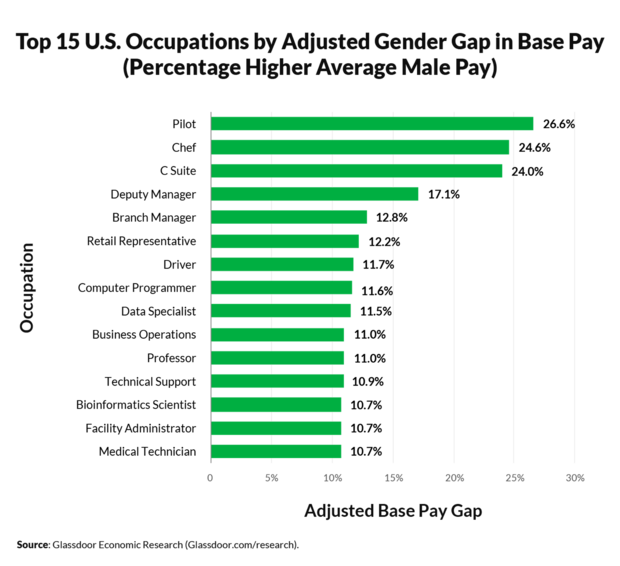Jobs where women face the biggest pay gaps
- Equal Pay Day marks the date women need to work into 2019 to earn what men were paid in the previous year.
- Women today earn 79 cents for every $1 men earn, according to separate studies from PayScale and Glassdoor.
- Even after adjusting for occupation, age, education and experience, women earn 4.9 percent less than men, Glassdoor found.
- Women in some occupations suffer from bigger pay gaps than others, including highly educated women.
Women in the U.S. have made significant inroads in the labor market, and many are their family's primary breadwinner. But the so-called gender pay gap -- the disparity between what women are paid at work compared with men's earnings -- remains stubbornly large, and even impacts the mostly highly educated women in America.
Women today earn 79 cents for every $1 men earn, according to separate studies from PayScale and Glassdoor, which analyzed salary data people provided to the companies. PayScale, a compensation-data company, and Glassdoor, a job-listing site, said they undertook the surveys ahead of Equal Pay Day on April 2, which marks the date women need to work into 2019 to earn what men were paid in the previous year.
That compensation gap may seem strikingly large, especially given that women today earn more college degrees than men. The primary cause boils down to different choices in occupations, Glassdoor noted. Women, for instance, are more likely to study social work in college -- a traditionally low-paying profession -- while men dominate college majors that lead to high-paying jobs, like engineering.
But even after adjusting for variables including occupation, age, education and experience, women earn 4.9 percent less than men, Glassdoor found. A woman engineer with the same experience and education as a male colleague earns an average of 4.9 percent less. On a dollar basis, that amounts to $81,000 less over a 30-year career -- about one year of lost salary for a typical professional, Glassdoor found.
Some of the discrepancy "surely is bias, because every year there are lawsuits about unfair pay by employers," said Andrew Chamberlain, chief economist at Glassdoor. A 4.9 percent gap "might seem small, but I view that as a significant pay difference. It's one of every 20 dollars being lost. That compounds over a career."
Biggest pay gaps
Some kinds of work have large gender pay gaps even after adjusting for occupation, experience and education. Many of those jobs are in traditionally male-dominated spheres, like pilots and chefs, which have the biggest and second-biggest gaps between male and female earnings, the study found.
Male pilots earn almost 27 percent more than women in the same roles, the study found. In other words, women pilots earn 73 cents for every $1 their male counterparts earn, even when they have the same title and experience.
MBA pay
The gender wage gap affects all types of women, not only those who earn middle-class wages. Women with MBAs -- a degree that can open doors to high-paying jobs in finance and business -- have the largest uncontrolled pay gap of any educational background, earning 74 cents for every $1 men earn, PayScale found. That hints that women with MBAs may be taking different types of titles or jobs in different industries than men, such as picking positions in the nonprofit sector, which tend to pay less.
"Our research shows the gender pay gap is multifaceted with many different factors contributing to pay inequity," said PayScale Vice President Lydia Frank in a statement. "As a result, every woman experiences the gender pay gap differently depending on her unique identities."
Snowball effect
That gap tends to widen as women get older, Glassdoor found. Women ages 18 to 24 earn 1.4 percent less than men, after adjusting for education, occupation and other factors. But by the time women are in their mid-50s to early 60s, the gap stands at 12.3 percent. Chamberlain said that's due to the snowball effect of lower pay as women change jobs over their careers.
"What happens is pay gaps can be compound as people carry over those pay gaps from job to job," he said. "So women start out at a lower base, and then that pay gap tends to grow over the years."
"Confidence gap"
There's also a "confidence" gap between men and women: More men describe themselves as confident in negotiating a pay raise than women describe themselves. They're also more likely than women to plan to ask for a pay raise in the next 12 months, Glassdoor found in a survey.
At the same time, women are less likely to feel fairly compensated than men, PayScale found in its study. That may suggest women are aware that male colleagues with similar experience and qualifications are earning more than they are.




